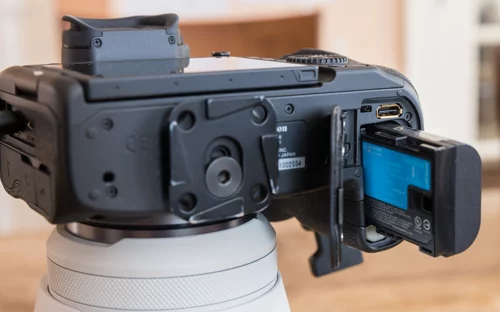Here’s what we didn’t know:
– Canon removed the 30 minute internal video recording limit.
– The standard 4k mode of the R3 is downsampled 6k video, and this just about matches the quality of the R5’s “HQ”
4k video.
– E-shutter goes to 1/64,000th of a second, for when you take a day-trip to the surface of the sun.
– The frame rate is adjustable downward from 30 FPS to 3- and 15-FPS. We suspect a lot of people are going to ride on the 15 setting.
– Its new “smart hotshoe” isn’t compatible with fancy flashes, and the adapters won’t be available until next year. It does have single-pin, old school functionality, and the flash sync port works.
– It handles heat better than the R5, but you can still overheat it. The high bitrate modes indicate at least an hour of shooting, but possibly more (reviewers typically saw 2 hours), depending on conditions. 4k 120p ALL-I mode can only run for 12 minutes. If you’re shooting super-slow-mo for more than 12 minutes of real-time shooting, then that’s not your biggest problem. It is likely that a Ninja V external recorder will make it go for hours.
– The pupil-directed focus point selection feature is geared mostly to initial focus point selection, rather than tracking. Importantly, it worked well for reviewers.
– There is no “resolution trick” as had been previously rumored. It’s. Just. 24 megabytes. Deal.
– The 30 FPS shots are full, 14-bit, non-compressed images (unlike the Sony A1, which will compress those files).
– The buffer is rated at 150 shots for RAW, and real-world performance might be closer to 135 shots. How fast the buffer clears isn’t known yet because the YouTubers given the camera for early reviews didn’t bother waiting to see. Jared Polin complained it was slower than the 1DX III, but he was shooting to both cards, including the slower SD card.
– Flash sync speed is 1/180th of a second with electronic shutter, which is better than nothing, but worse than the 1/200th seen in the Sony A1.
– The rolling shutter is well controlled for stills, as expected with the stacked sensor, but it’s only about half as well controlled for video.
– The camera shoots 6k 60p and 4k oversampled up to 60p or normal 4k at 120p for super-slow-mo.
– It has Canon Log3, but none of the other “clogs.”
– The battery lasted 4-5 hours of heavy use, but was about empty for the DPReview TV crew. One reviewer shot more than 2 hours of a single video on a single battery in downsampled 4k.
– Not a single reviewer has indicated that the image quality is better than the R5 or 1DX Mark III. Gordon Laing did the best side-by-side comparisons, and his comparative ISO shots show that there is a bunch of noise reduction cooking going on after ISO 6400, making for smoother, usable images at the expense of detail.
– GPS is internal to the camera, eschewing the seldom-convenient smartphone wireless links.
– It supports Apple MFI connections to iDevices, which may open up direct app control that doesn’t rely on janky Canon software network preferences and connection rigamarole.
– The HDMI-out port is just mini-HDMI, unfortunately.
– The viewfinder shows no lag or blackout.
– There is an optical viewfinder simulator which sacrifices digital display and TTL features for a high definition view, and this was actually used and found desirable at times by reviewers.
– The new 400mm and 600mm lenses can be driven faster by the R3 due to higher voltage, Canon is now calling “Dual Power.” No one has publicly tested this yet to show to what degree the AF is quickened.
– Reviewers aren’t showing a noticeable jump in high-ISO performance despite the move to a backside illuminated sensor. It is likely improved, but it hasn’t proved notable to reviewers.
– Mechanical shutter is about as fast as the R5, lacking the 1DX Mark III’s 20 FPS version.
– The new “vehicle” AF tracking feature is geared mostly to racing vehicles. It will pick up a racing motorcycle sooner than it will a minivan.
– Canon has finally let go of the customization limitations, allowing most buttons to be customized to most functions. The Q menu can also be customized; so welcome back to 2018.
– The camera’s tracking can now be limited to specific focus zones, and these are now more customizable in shape.
– Flicker detection is now more customizable so that the camera will match high frequency LED lights.
– The autofocus appears to be faster and more accurate. Shots from a fast-moving, approaching target nail the eye at f/1.2 at 30 FPS.
– It appears to be tough. Peter McKinnon dropped his loaner from about 50 feet onto grass (because, of course, he had it mounted to an FPV drone that could maximally carry a camera about 1/4th this weight), and the f/1.2 lens busted in half at the mount, but the R3 was good to go. Your mileage will likely vary, depending on luck and your current level of stupidity.
– As Gordon Laing mentioned in his part two of his videos on the R3, one big surprise is that we have so far not discovered any major “gotchas.” For the most part, Canon is offering a product that has equal or better features, barring resolution, and with a consistency that is unusual for a Canon body launch.
Hands-on reviews can be found here by DPReview TV guys and here by Gordon Laing.


 Tilt Shift Calculator
Tilt Shift Calculator POWERING THE EOS R5
POWERING THE EOS R5 R5 Portal
R5 Portal Camera
Camera Lens
Lens Batteries
Batteries Memory Cards
Memory Cards

